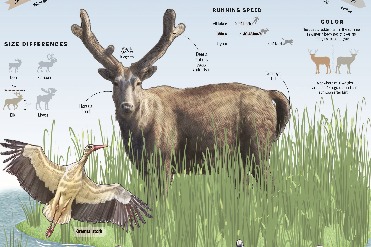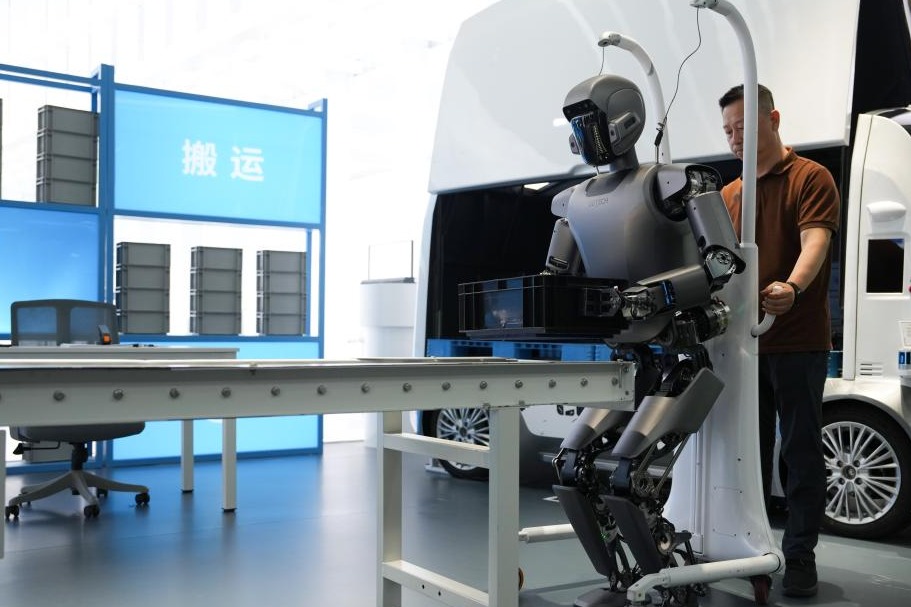Tourism takes flight over blossoming countryside

As spring sweeps across most of China, temperatures are rising and people are eager to embark on journeys to witness stunning floral spectacles.
The growing popularity of flower-viewing tourism has given a vibrant boost to the springtime economy, with modern technology playing an important role in driving this trend.
Adding vibrancy
From late March to April, vast fields across China's countryside are carpeted in dazzling yellow rapeseed flowers, creating breathtaking landscapes.
Social media comes alive with photos of people adorned with flower garlands, celebrating the season's charm. However, the yellow blossoms in Jiangxi province are part of a colorful display, with cherry pink, peach red, snow white and light purple blooms coming as a painting from nature's palette.
These multicolored flowers are the result of 11 years of research by Fu Donghui, a professor at Jiangxi Agricultural University. His team has cultivated a wide range of species in 75 colors. The widespread popularity of "bloom chasing" photos online years ago made Fu realize that the sea of rapeseed flowers had the potential to become a signature tourism attraction. However, the single yellow color could lead to aesthetic fatigue, limiting the industry's growth.
Since 2014, Fu has used genetic engineering and hybrid breeding to create new colors, such as introducing the purple gene from radishes into rapeseed flowers.
The tech-enhanced blooms have revitalized local tourism, transforming scenic spots featuring the colorful rapeseed flowers into popular photography destinations. Visitors flock to these vibrant landscapes, feeling as if they have stepped into a Chinese version of Monet's Garden.
Fu's team has forged cooperation with over 100 scenic spots for scientific demonstration planting, boosting rapeseed flower-themed tourism in over 20 provinces.
These genetically engineered flowers offer more than just a visual feast. They make real contributions to the industrial economy, as they have been proven to yield higher rapeseed production as well as oil output.
Rapeseed is one of China's primary oilseed crops, with its annual planting area and total production ranking among the highest globally.
Aerial adventure
This year's peak flower season is being blended with the latest tech trends. In addition to the traditional flower-viewing walks, visitors to Chengdu, Sichuan province, can board fixed-wing aircraft or helicopters, soaring just a few hundred meters above the ground to take in sweeping views of the vast floral landscapes.
Despite waiting five hours due to airspace restrictions, a tourist surnamed Zhao said her 10-minute helicopter ride last week at helicopter club Flight Now was still a "worthwhile experience".
The club said that on weekends, the number of daily flights can reach 30 to 40. Beyond aerial sightseeing, there is also a growing demand from tourists for hands-on aircraft flying experiences.
Data from e-commerce platform Meituan showed that the number of merchants launching "helicopter ride" and "sky-high tour" services on the platform has doubled year-on-year, and the number of group bookings for such low-altitude flight services has nearly quadrupled.
Airports in cities such as Chengdu and Shenzhen, Guangdong province, have also tapped into the flower-themed tourism market, launching a growing number of routes for flying over blossoms since March.
The low-altitude flower phenomenon provides more than a fresh lens to appreciate nature. It is a trend of modern tourism that integrates cutting-edge aviation with scenic exploration. Fancy flying vehicles, such as electric vertical take-off and landing aircraft, unmanned aerial vehicles and future-oriented aircraft are poised to open new air routes across China, pioneering the next chapter of aerial tourism.
In the city of Tianshui in Gansu province, visitors can board a vertical take-off and landing aircraft and enjoy a low-altitude flight at 300 meters to view the 1,600-year-old Maijishan Grottoes.
Hefei-based Zero Gravity Aircraft Industry has designed a spacecraft-like unmanned electric flying vehicle called the ZG-ONE, a star product that consistently attracts attention at exhibitions across China. It is specifically aimed at low-altitude tourism and short-distance travel.
State-owned enterprises such as the Aviation Industry Corporation of China are also entering the market, developing civil airships such as the AS700 for scenic tours.
China recently made public a plan on special initiatives to increase consumption, highlighting the orderly development of low-altitude consumption sectors, including low-altitude tourism, aviation sports and consumer-grade drones.
Zhao Deli, founder of the Chinese flying car company Xpeng Aeroht, said that the policy will infuse new vitality into the development of the market. "This includes accelerating infrastructure construction, attracting greater capital investment and encouraging increased consumer participation," Zhao said.
State-owned giants such as the Aviation Industry Corporation of China are also entering the market, developing civil airships such as the AS700 for scenic tours.
Xinhua


Today's Top News
- Grassroots Party units continue to play key role
- Global investors double down on Chinese assets
- FM's visit to Europe seen as boosting ties
- Liar's speeches reflect separatists' desperation: China Daily editorial
- Shared responsibility to contribute valuable stability and certainty to a turbulent world
- Xi stresses advancing full, rigorous Party self-governance through forging good conduct






























